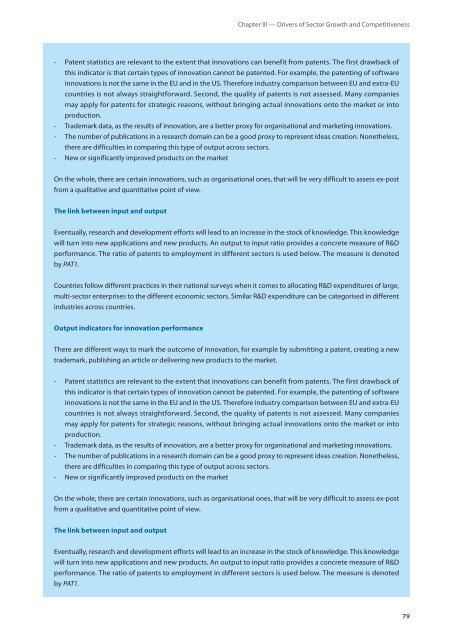EU industrial structure - EU Bookshop - Europa
EU industrial structure - EU Bookshop - Europa
EU industrial structure - EU Bookshop - Europa
You also want an ePaper? Increase the reach of your titles
YUMPU automatically turns print PDFs into web optimized ePapers that Google loves.
Chapter III — Drivers of Sector Growth and Competitiveness<br />
‑ Patent statistics are relevant to the extent that innovations can benefit from patents. The first drawback of<br />
this indicator is that certain types of innovation cannot be patented. For example, the patenting of software<br />
innovations is not the same in the <strong>EU</strong> and in the US. Therefore industry comparison between <strong>EU</strong> and extra‑<strong>EU</strong><br />
countries is not always straightforward. Second, the quality of patents is not assessed. Many companies<br />
may apply for patents for strategic reasons, without bringing actual innovations onto the market or into<br />
production.<br />
‑ Trademark data, as the results of innovation, are a better proxy for organisational and marketing innovations.<br />
‑ The number of publications in a research domain can be a good proxy to represent ideas creation. Nonetheless,<br />
there are difficulties in comparing this type of output across sectors.<br />
‑ New or significantly improved products on the market<br />
On the whole, there are certain innovations, such as organisational ones, that will be very difficult to assess ex‑post<br />
from a qualitative and quantitative point of view.<br />
the link between input and output<br />
Eventually, research and development efforts will lead to an increase in the stock of knowledge. This knowledge<br />
will turn into new applications and new products. An output to input ratio provides a concrete measure of R&D<br />
performance. The ratio of patents to employment in different sectors is used below. The measure is denoted<br />
by PAT1.<br />
Countries follow different practices in their national surveys when it comes to allocating R&D expenditures of large,<br />
multi‑sector enterprises to the different economic sectors. Similar R&D expenditure can be categorised in different<br />
industries across countries.<br />
Output indicators for innovation performance<br />
There are different ways to mark the outcome of innovation, for example by submitting a patent, creating a new<br />
trademark, publishing an article or delivering new products to the market.<br />
‑ Patent statistics are relevant to the extent that innovations can benefit from patents. The first drawback of<br />
this indicator is that certain types of innovation cannot be patented. For example, the patenting of software<br />
innovations is not the same in the <strong>EU</strong> and in the US. Therefore industry comparison between <strong>EU</strong> and extra‑<strong>EU</strong><br />
countries is not always straightforward. Second, the quality of patents is not assessed. Many companies<br />
may apply for patents for strategic reasons, without bringing actual innovations onto the market or into<br />
production.<br />
‑ Trademark data, as the results of innovation, are a better proxy for organisational and marketing innovations.<br />
‑ The number of publications in a research domain can be a good proxy to represent ideas creation. Nonetheless,<br />
there are difficulties in comparing this type of output across sectors.<br />
‑ New or significantly improved products on the market<br />
On the whole, there are certain innovations, such as organisational ones, that will be very difficult to assess ex‑post<br />
from a qualitative and quantitative point of view.<br />
the link between input and output<br />
Eventually, research and development efforts will lead to an increase in the stock of knowledge. This knowledge<br />
will turn into new applications and new products. An output to input ratio provides a concrete measure of R&D<br />
performance. The ratio of patents to employment in different sectors is used below. The measure is denoted<br />
by PAT1.<br />
79
















